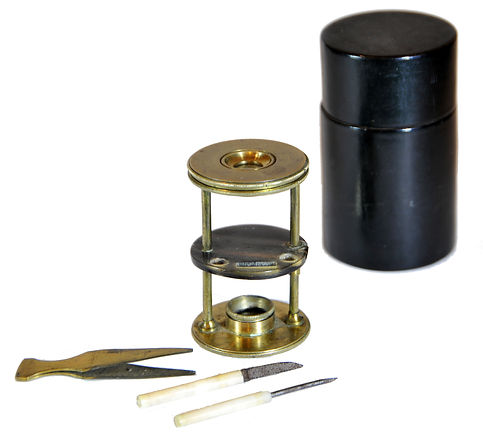

Withering-type botanical microscope, 1780
The “Withering-type Microscope” is named for its inventor, Dr. William Withering (1741-1799), an English physician and botanist who graduated with a degree in medicine 1766 in Edinburgh. Inspired by the taxonomical work and systematic classification of Carl Linnæus (1707-1778), Withering (1776) applied the Linnaean taxonomical system of classification to British plants in a seminal, two volume work, A Botanical arrangement of all the vegetables naturally growing in the British Isles. The earliest reference to a small botanical microscope of Withering’s design appeared in the first edition of this book. There, Withering indicated this microscope was developed for field dissections of flowers and other plant parts. While there is no surviving example of this exact design, close relatives of this type do exist, made either completely of brass or of ivory with brass pillars. Ivory models can be tentatively dated to 1776-1785, as by 1787 a newer model with a hollowed stage in an all-brass configuration already predominated. In turn, it was preceded by the brief appearance of a transitional brass model but with solid stage of ivory or horn (seen here). This version is extremely rare and must have been produced in very small numbers. By 1787 all these varieties were not recorded anymore in the literature.

Withering-type botanical microscope, 1780
The “Withering-type Microscope” is named for its inventor, Dr. William Withering (1741-1799), an English physician and botanist who graduated with a degree in medicine 1766 in Edinburgh. Inspired by the taxonomical work and systematic classification of Carl Linnæus (1707-1778), Withering (1776) applied the Linnaean taxonomical system of classification to British plants in a seminal, two volume work, A Botanical arrangement of all the vegetables naturally growing in the British Isles. The earliest reference to a small botanical microscope of Withering’s design appeared in the first edition of this book. There, Withering indicated this microscope was developed for field dissections of flowers and other plant parts. While there is no surviving example of this exact design, close relatives of this type do exist, made either completely of brass or of ivory with brass pillars. Ivory models can be tentatively dated to 1776-1785, as by 1787 a newer model with a hollowed stage in an all-brass configuration already predominated. In turn, it was preceded by the brief appearance of a transitional brass model but with solid stage of ivory or horn (seen here). This version is extremely rare and must have been produced in very small numbers. By 1787 all these varieties were not recorded anymore in the literature.
References: SML: A242712; Goren 2014.
References: SML: A242712; Goren 2014.
Prof. Yuval Goren's Collection of the History of the Microscope

© Microscope History all rights reserved

© Microscope History all rights reserved
Aquatic Microscope by Robert Banks, ~1825
The firm of Robert Banks (or Bancks as it is sometimes spelled on some microscopes) traded at 440/441 Strand in London between 1795 and 1830. They were entitled instrument maker to the Prince of Wales and signed their instruments as both Banks and Bancks.
The "aquatic microscope" is the type originally designed for Abraham Trembley and later for John Ellis by John Cuff in 1752, in order to follow the activity of small water organisms held on a watch glass on a microscope stage. The design became popular and various forms of this design were made in England and Europe. Robert Banks was highly regarded as a distinguished maker of these.
The same type of Banks microscope as the example seen here, was used by Robert Brown (1773-1858) in his pioneering studies of cell nuclei and Brownian motion, by Sir William Jackson Hooker (1785-1865) in writing his Musci Exotici (1820), and by George Bentham (1800-1884) for his plant dissections and taxonomy. Per Robert Brown's advise, young Charles Darwin (1809-1882) bought a similar microscope from Banks (signed Bancks) to take on the 1831-5 voyage of HMS Beagle to South America, the Galapagos Islands and around the world. Between 1846 and 1854 Darwin employed this microscope for his study of the biology and taxonomy of barnacles, after which he suggested some improvements to the design to the microscope makers Smith and Beck.

Charles Darwin's microscope of HMS Beagle voyage
(Source: https://docs.wixstatic.com/ugd/36f314_48a605b775054b8595d8997119ad3449.pdf)

Robert Brown's microscope in the Kew Gardens
(Source: https://www.anbg.gov.au/botanical-history/microscope-robert-brown.html)
References: Ford 1985, chap. 9-10; SML: A140457; Whipple: 1823, Wh.0244; NMS Edinburgh: 000-100-104-260-C; MHS: 47692; Boerhaave: V10768; Nuttall 1979: 1; Sydney Mus.: H5292.

© Microscope History all rights reserved